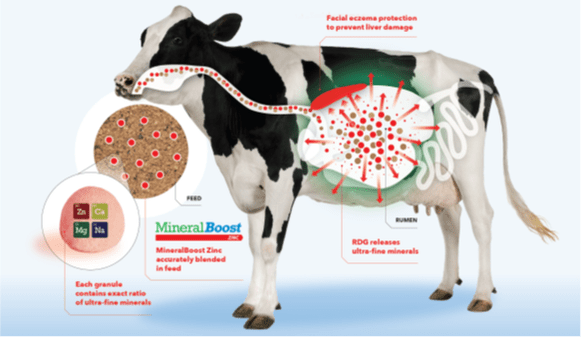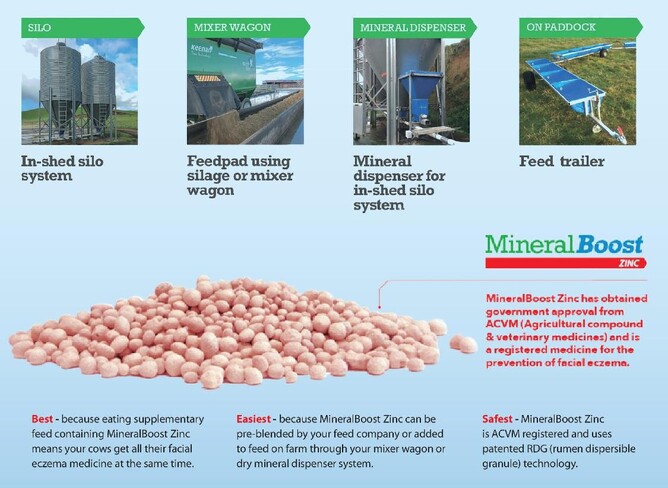Facial eczema should really be called sporidesmin toxicity as the classic skin damage does not occur in all animals and is not always correlated with the real severity of the disease.
Facial eczema is primarily a disease of the liver (sporidesmin is a hepatotoxin). The liver is the powerhouse of production in cattle and determines the health, productivity and quality of that life.
Most things entering the system from the diet go to the liver first which puts it at significant risk. The skin damage associated with facial eczema is a major welfare issue but it is really a side effect of the reduced ‘work’ capability of the liver itself.
Because of the importance of the liver to the optimum health, productivity and survival of the cow, the goal should be to prevent all and any injury from sporidesmin, the toxin produced by the spores of the fungus Pithomyces chartarum, throughout the whole life of the cow.
One proven successful way of preventing much of the liver damage caused by facial eczema toxin sporidesmin, is to administer zinc at higher levels than those needed for daily life. For zinc to be most effective and for it to reduce or eliminate all potential liver damage, it must be given early enough in the risk period, it must be given at sufficient rates and administration must continue for long enough.
Failure to start treatment early enough, ideally as counts begin to rise (or just before) means that the scene is set for much more severe damage to occur than necessary – this is a cumulative problem. Lots of small individually insignificant ‘insults’ add up, often to just as much damage as a single large hit.
Don’t delay, but begin at low levels. Avoiding early damage and already having some zinc in the system makes it much easier to respond to very high counts or a sudden rise. It is the young spores of a rising count that are the most dangerous.
Using zinc for facial eczema prevention
Zinc oxide and Zinc sulphate are the two most commonly used forms of zinc. Zinc oxide is an insoluble powder, zinc sulphate is water soluble and comes as either zinc monohydrate or zinc heptahydrate.
Supplementation
Begin early enough, even if at 25-30% of standard rates. This is one of the biggest causes of failures. You can always increase or decrease rates in line with spore count and risk, you cannot fix liver damage, nor is it easy to get very high doses into animals when counts have already risen to dangerous levels.
Use a method that is convenient, reliable and delivers the correct amount of zinc to all animals, without risk.
While it seems simple, water treatment is rarely well done. There are a number of problem areas, including palatability. Put some zinc sulphate in water at the concentration you expect your cows to drink it and taste it. Good luck!
Anything that reduces total water intake or changes drinking behaviour will affect feed conversion efficiency negatively. While there are obvious issues such as water leaks and lower consumption in wet weather, too many New Zealand farms simply do not have enough trough space.
Water systems have a lot of dead space, water which needs to be primed before cows get any zinc in the paddock – there will be hundreds of metres of piping, plus untreated water already in troughs. It can be days after the start of treatment before animals actually consume the required levels of zinc (if ever). This is often too late. Sometimes not all water sources are being treated, or animals look for more palatable water such as puddles.
As always, the fewer unpalatable additives in water, the better – even flavourings have limited long-term effectiveness.
Mono and heptahydrate forms can get confused resulting in inaccurate dosing.
Zinc oxide is usually a better option but again it’s all about starting early enough and ensuring all animals get the correct daily dose.
Zinc oxide can be drenched, which in itself is physically demanding. This is not always an easy product to keep in solution and is not always compatible with other compounds of the drench mix. While daily drenching ensures all animals get zinc, usually all animals get the same amount daily regardless of size or need. As with water, this means that it is possible to see both zinc toxicity and facial eczema in the same mob at the same time.
Zinc oxide can be added to feed and in many cases as feed intake is determined more by cow size and need, a more even protective level of zinc is achieved.
Zinc oxide is a powder – it can be unpleasant to handle, especially in windy conditions, which means it needs careful mixing and can separate out.
For conventional wagons and feed troughs, (eg; palm kernel troughs), some physical effort is required to get good distribution, which is not as easy as it seems with small amounts of powdered zinc oxide.
Powders added to in-shed systems mean unpleasant dust in the feed which cows do not like. Powders in feed can settle out both before and during feeding, so not all ‘mouthfuls’ contain the same amount of zinc.
These problems can all be overcome by producing the zinc oxide in a granule. As an added bonus, granules can be made up to contain calcium (reducing subclinical or clinical hypocalcaemia issues), salt (increasing palatability) and magnesium with all of the minerals mixed together in a predetermined correct ratio.
Given a standard amount of zinc oxide per kilogram of granules, it is easy to calculate daily requirements. More significantly granules are easier to mix, are more palatable, don’t settle out and can be used in all types of feed systems for all classes of stock. Granules can be premixed into feed prior to delivery or added on farm.
Mineral Boost Zinc is ideal for this purpose.
Want to know more?
We're here to help. Feel free to reach out to one of our representatives here.





